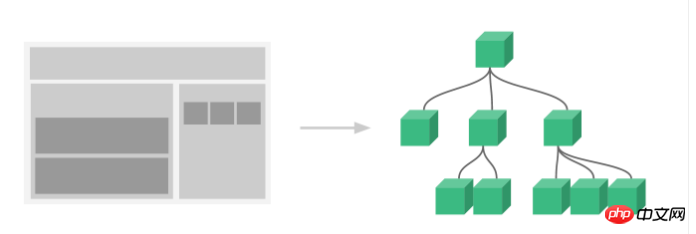如何使用vue註冊元件
- php中世界最好的语言原創
- 2018-05-23 14:56:182182瀏覽
這次帶給大家如何使用vue註冊元件,使用vue註冊元件的注意事項有哪些,以下就是實戰案例,一起來看一下。
一、介紹
元件系統是Vue.js其中一個重要的概念,它提供了一個抽象,讓我們可以使用獨立可重複使用的小元件來建構大型應用,任一類型的應用介面都可以抽象化為一個元件樹

那麼什麼是元件呢?
元件可以擴充HTML元素,封裝可重複使用的HTML程式碼,我們可以將元件視為自訂的HTML元素。
二、如何註冊元件
Vue.js的元件的使用有3個步驟:建立元件建構器、註冊組件和使用組件。

下面用程式碼示範這三步驟
<!DOCTYPE html>
<html>
<body>
<p id="app">
<!-- 注意: #app是Vue实例挂载的元素,应该在挂载元素范围内使用组件-->
<my-component></my-component>
</p>
</body>
<script src="https://cdn.jsdelivr.net/npm/vue/dist/vue.js"></script>
<script>
<!-- 1.创建一个组件构造器 -->
var myComponent = Vue.extend({
template: '<p>This is my first component!</p>'
})
<!-- 2.注册组件,并指定组件的标签,组件的HTML标签为<my-component> -->
Vue.component('my-component', myComponent)
<!-- 3.通过id=app进行挂载 -->
new Vue({
el: '#app'
});
</script>
</html>
運行結果如下:

# 一、 全域註冊和局部註冊
呼叫Vue.component()註冊元件時,元件的註冊是全域性的,這表示該元件可以在任何Vue範例下使用。
如果不需要全域註冊,或是讓元件使用在其它元件內,可以用選項物件的components屬性實現局部註冊。
我自己的理解只要是component就代表全域元件,components代表局部元件
上面的範例可以改為局部註冊的方式:
<!DOCTYPE html>
<html>
<body>
<p id="app">
<!-- 3. my-component只能在#app下使用-->
<my-component></my-component>
</p>
</body>
<script src="js/vue.js"></script>
<script>
// 1.创建一个组件构造器
var myComponent = Vue.extend({
template: '<p>This is my first component!</p>'
})
new Vue({
el: '#app',
components: {
// 2. 将myComponent组件注册到Vue实例下
'my-component' : myComponent
}
});
</script>
</html>
由於my-componentent元件是註冊在#app元素對應的Vue實例下的,所以它不能在其它Vue實例下使用。
<p id="app2">
<!-- 不能使用my-component组件,因为my-component是一个局部组件,它属于#app-->
<my-component></my-component>
</p>
<script>
new Vue({
el: '#app2'
});
</script>
二、元件註冊語法糖
# 以上元件註冊的方式有些繁瑣,Vue.js為了簡化這個過程,提供了註冊語法糖
// 全局注册,my-component1是标签名称
Vue.component('my-component1',{
template: '<p>This is the first component!</p>'
})
var vm1 = new Vue({
el: '#app1'
})
Vue.component()的第1個參數是標籤名稱,第2個參數是選項對象,使用選項對象的template屬性定義元件範本。
使用這種方式,Vue在背後會自動地呼叫Vue.extend()。
components實作局部註冊
var vm2 = new Vue({
el: '#app2',
components: {
// 局部注册,my-component2是标签名称
'my-component2': {
template: '<p>This is the second component!</p>'
},
// 局部注册,my-component3是标签名称
'my-component3': {
template: '<p>This is the third component!</p>'
}
}
}
三、父元件和子元件
我們可以在元件中定義並使用其他元件,這就構成了父子組件的關係。
<!DOCTYPE html>
<html>
<body>
<p id="app">
<parent-component>
</parent-component>
</p>
</body>
<script src="https://cdn.jsdelivr.net/npm/vue/dist/vue.js"></script>
<script>
var Child = Vue.extend({
template: '<p>This is a child component!</p>'
})
var Parent = Vue.extend({
// 在Parent组件内使用<child-component>标签
template :'<p>This is a Parent component</p><child-component></child-component>',
components: {
// 局部注册Child组件,该组件只能在Parent组件内使用
'child-component': Child
}
})
// 全局注册Parent组件
Vue.component('parent-component', Parent)
new Vue({
el: '#app'
})
</script>
</html>
這段程式碼的運作結果如下

四、使用script或template標籤
儘管語法糖簡化了組件註冊,但在template選項中拼接HTML元素比較麻煩,這也導致了HTML和JavaScript的高耦合性。
慶幸的是,Vue.js提供了兩種方式將定義在JavaScript中的HTML模板分離出來。
<!DOCTYPE html>
<html lang="en">
<head>
<meta charset="UTF-8">
<title>vue组件</title>
<script src="js/vue.js"></script>
</head>
<body>
<p id="app1">
<my-com></my-com>
<my-com1></my-com1>
</p>
<template id="myCom">
<p>这是template标签构建的组件</p>
</template>
<script type="text/x-template" id="myCom1">
<p>这是script标签构建的组件</p>
</script>
<script src="https://cdn.jsdelivr.net/npm/vue/dist/vue.js"></script>
<script>
Vue.component('my-com1', {
template: '#myCom1'
});
var app1 = new Vue({
el: '#app1',
components: {
'my-com': {
template: '#myCom'
}
}
});
</script>
</body>
</html>
運行結果:

注意:使用

